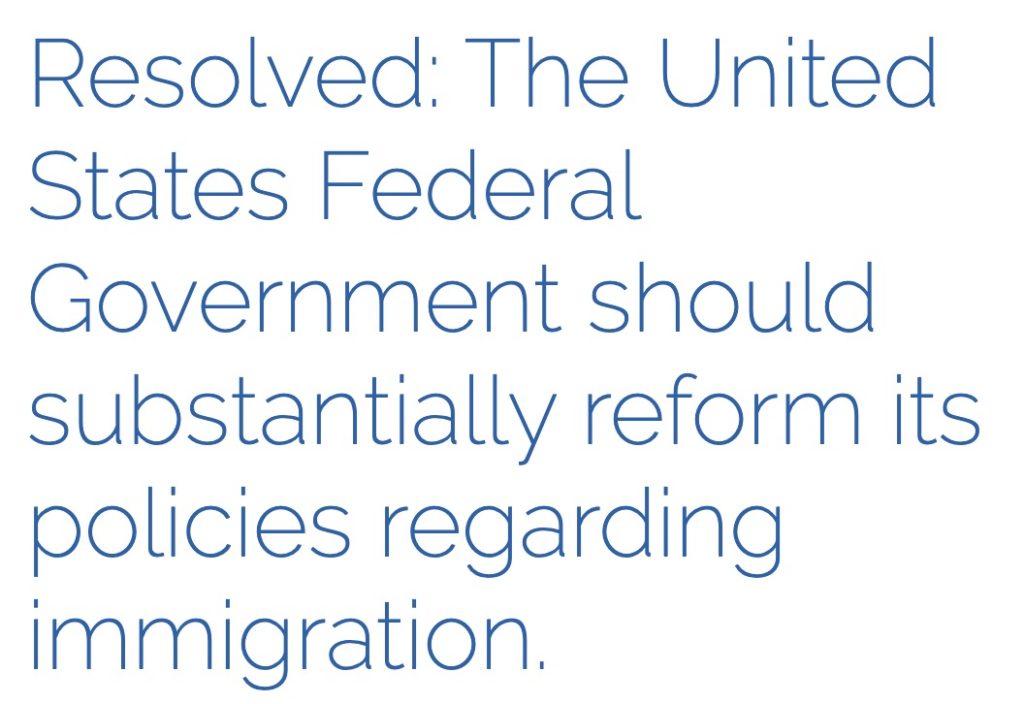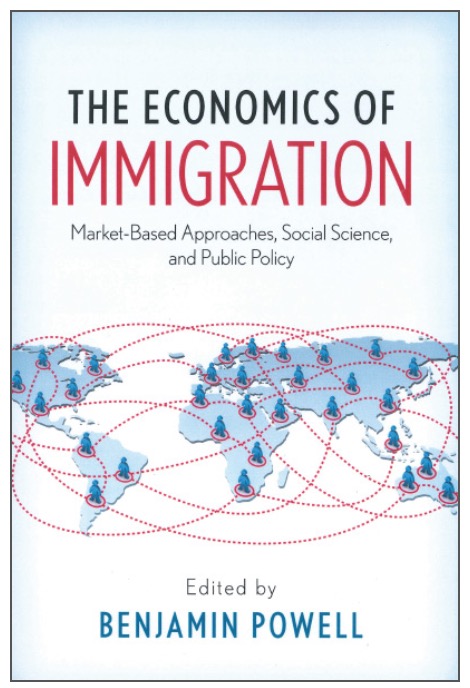Notes on NCFCA Policy Resolutions: Immigration, FDA, Energy Policy
[June 5 update: energy policy topic chosen.]
Ace Peak posted debate notes on the NCFCA policy resolution choices of immigration reform, FDA reform, and USFG energy policy reform.
Economic Thinking workshops, blog posts, and videos focus on teaching economic principles, and helping students apply those principles to chosen debate topics. Economists have published many studies and books on each of these three resolutions.

Looking at Immigration Reform
Legal immigration reform is the current NSDA public school topic, and I’ve been posting and tweeting on immigration policy over the last year. Economic Thinking immigration posts are here. Twitter posts (via NCPA DebateCentral) here. The NSDA topic called for increasing legal immigration, so tried to avoid dealing with the ongoing controversies about illegal immigration, border walls, caravans, and family separations. (I can’t speak to the Ace Peak concern that the current wording calls for reforming “policies regarding immigration” rather than “immigration policy.”)
In considering immigration reform, it is key I think to separate federal labor policy from welfare and naturalization policies. Some affirmative approaches to the topic note that the Constitution grants the federal government naturalization policy (how immigrants apply for citizenship), but not over immigration itself (apart from safety and public health concerns). So immigrants can be checked for infectious diseases and against profiles of criminal and terrorists. But Federal government power to guess how many agricultural or tech workers should be allowed in the country, or how many entrepreneurs or rich people or relatives or refugees, these arbitrary powers are the result of decades of interventionist dynamics influenced by labor, corporate, and environmental lobbying. In the beginning though, Eugenics and progressive era policies led to immigration restrictions in the 1880s and early 1900s.
Straightforward immigration reforms would be to have the federal government focus on national security and public health (stop immigration of criminals, terrorists, and check for infectious diseases). Critics of open immigration focus on welfare programs, public schools, and hospital emergency care as in danger of being overwhelmed by illegal immigration.
There is obviously a lot of history, economics, politics, and cultural issues regarding immigration policy. The Obama Administration clamped down on illegal immigration, under pressure from labor unions, and the Trump Administration has called for further steps, including further militarizing the border. Immigration has become even more politicized than it used to be, with the ongoing border mismanagement being used to club political opponents.
The current booming economy and historically low unemployment rates make it politically easier to expand legal immigration than it would be during a recession with high unemployment. In Legal Immigration, Freedom of Movement, and National Sovereignty (Economic Thinking, October 10, 2018), I mention On immigration, let the states decide for themselves (USA Today, August 4, 2017) and Let the states decide: Congress shows no sign of fixing America’s broken immigration system. It is time to give the states a go (The Economist, February 5, 2015).
And in a post earlier today on a proposed Stoa league labor policy topics, I discuss complex and convoluted Department of Labor work visa programs that cost U.S. farmers millions, plus make life difficult for tech and other industries who need specialized workers.
The NBA seems to be able to get work visas or citizenship for all the basketball players it wants from Africa, Eastern Europe, Turkey, and Australia, why shouldn’t other industries be able to hire the workers they need?

The Vernon K. Krieble Foundation’s Red Card Solution calls for private firms to manage work visas, with focus on safety and security. See The Red Card Solution: How it Works. http://redcardsolution.com/
See No Better Foreign Aid than Labor Mobility, or for Boosting U.S. Economy (Economic Thinking, February 22, 2019), was written for the foreign aid topic, but the focus is on outdated U.S. labor laws. Labor unions and progressives (and some conservatives) claim that workers from other countries hurt U.S. workers or drive down wage rates. But the benefits of labor mobility are far higher to American workers, companies, and consumers. Benefits from foreign workers are similar to benefits from foreign tourists:
Legal rules that govern foreign labor, are very different than for tourism. Why is that? Tourists spend money for meals, housing, entertainment when they tour foreign cities and sites. But so do workers from other countries. Visiting workers purchase local food, rent or buy housing, and spend money on clothing and entertainment. Why are regulations for the U.S. and other countries so different for tourism than for labor?
As more tourists arrive and boost demand for hotels and local attractions, companies and entrepreneurs dream up more attractions and build more hotels. Disneyland and Disney World are crowded with tourists from around the world, but they can expand, and new amusement parks are developed to profit from more and more tourists.
Similarly, as more visiting workers arrive, they attract investments in more housing and entertainment, as well as more factories offering more jobs. Hotel owners make money and expect to profit from visiting tourists renting their rooms. Similarly, factory owners and farmers make money as visiting workers take on tasks that allow profitable manufacturing and agriculture
See No Better Foreign Aid than Labor Mobility, or for Boosting U.S. Economy (Economic Thinking, February 22, 2019),
Expanding immigration is forty times more effective in helping poor people from developing countries than the most effective foreign aid programs. And legal immigrants provide large benefits to U.S. companies, workers, and consumers. Some on low-skill professions face competition from new immigrants, but most do not. In support of these claims, see: The Economics of Immigration: Market-Based Approaches, Social Science, and Public Policy (Ben Powell, editor, Oxford University Press, September 21, 2015):

Combining rigor and readability, The Economics of Immigration offers important findings and bold ideas that will appeal to a variety of readers. General readers who absorb its lessons will be well equipped to dispel widespread myths about the effects of immigration. Policymakers and pundits will be struck by its non-partisan tone, and its clear-headed proposals capable of bridging the political divide. And scholars will appreciate the book’s reviews of numerous studies, all in one volume.

Substantially reform the Food and Drug Administration (FDA)
For the FDA topic, again there is a lot of history and some controversy relevant to reform proposals. Perhaps the easiest or safest FDA reform would be a small edit to the FDA mandate. Billions of dollars could be saved each year and thousands of lives, by returning the FDA’s role to making sure drugs are safe, rather than trying to make sure drugs are “safe and effective.”
Doug Bandow, In End the FDA Drug Monopoly: Let Patients Choose Their Medicines (Cato Commentary and Forbes, June 11, 2012), writes:
…it would be better to strip the Food and Drug Administration of its monopoly control over pharmaceutical development.
The FDA was created in 1906, before prescription drugs became a leading medical treatment. The 1962 Kefauver-Harris Amendments vastly expanded agency control over drug approval, giving the FDA, which also regulates most food products, cosmetics, vitamin and dietary supplements, the power to determine efficacy as well as safety of new pharmaceuticals.
Many reforms are proposed. One of the most conservative would doctors and consumers to access to pharmaceuticals (and medical devices) approved by the E.U. or Japan, in addition to the FDA:
One approach would be to allow the sale of pharmaceuticals (and medical devices) approved by the regulatory agencies of other industrialized states. If an industrialized Asian or European nation has released a product to market, it could legally be sold in America, subject to a showing of unreasonable danger.
End the FDA Drug Monopoly: Let Patients Choose Their Medicines (Cato Commentary and Forbes, June 11, 2012)

Substantially reform USFG energy policy
The Departments of Energy and Education were created during the Carter Administrations. Candidate Ronald Reagan ran for President calling for abolishing both federal agencies. Federal politicians and employees of the Department of Energy have limited knowledge, incentives, and ability to research, produces, or distribute energy.
An advocate for the Department of Energy, in Republicans Want To Shut Down The Department Of Energy. Here’s Why That’s A Really Bad Idea:, Forbes, November 23, 2015), defends the $27 billion Department of Energy from calls by Senator Ted Cruz to defund it, claiming:
…the main activities of the agency—nuclear defense, scientific research and empowering innovation—are essential programs that we couldn’t do without.
Downsizing the Federal Government takes a different view of the Department of Energy:
The Department of Energy oversees nuclear weapons sites and subsidizes conventional and alternative fuels. It has a history of fiscal and environmental mismanagement, and its misguided energy regulations have caused large losses to consumers and the broader economy over the decades.
The department runs 34 subsidy programs, and will spend $28 billion in 2018, or $220 for every U.S. household. It employs 16,000 workers directly and oversees about 100,000 contract workers at research facilities across the nation.
Debaters can rejoice at having another opportunity to abolish ethanol subsidies and mandates! (See Ethanol and Biofuel Policies, February 9, 2017).
The Department of Energy runs a great many programs that confound and irritate consumers, including regulating light bulbs and home appliances. These will be fun for students to research. The Department of Energy claims, for example:
The Building Technologies Office (BTO) implements minimum energy conservation standards for more than 60 categories of appliances and equipment. As a result of these standards, American consumers saved $63 billion on their utility bills in 2015 alone. By 2030, cumulative operating cost savings from all standards in effect since 1987 will reach nearly $2 trillion.
Office ofENERGY EFFICIENCY & RENEWABLE ENERGY: Appliance and Equipment Standards Program
It is worth asking how much it cost American consumers to save this $2 trillion since 1987. That is, how much have Department of Energy regulations raised the cost of home appliances and/or reduced how long they last. New Energy Efficiency Standards for Residential Clothes Washers and Dishwashers to Save Consumers Billions on Energy Bills, Energy.gov, May 16, 2012) makes similar claims to save consumers billions of dollars in energy costs.
How Washington Ruined Your Washing Machine, (Wall Street Journal, March 17 2011):
In 1996, top-loaders were pretty much the only type of washer around, and they were uniformly high quality. When Consumer Reports tested 18 models, 13 were “excellent” and five were “very good.” By 2007, though, not one was excellent and seven out of 21 were “fair” or “poor.” This month came the death knell: Consumer Reports simply dismissed all conventional top-loaders as “often mediocre or worse.”
How’s that for progress?
The culprit is the federal government’s obsession with energy efficiency. Efficiency standards for washing machines aren’t as well-known as those for light bulbs, which will effectively prohibit 100-watt incandescent bulbs next year. Nor are they the butt of jokes as low-flow toilets are. But in their quiet destruction of a highly affordable, perfectly satisfactory appliance, washer standards demonstrate the harmfulness of the ever-growing body of efficiency mandates.
For Department of Energy light bulb regulation, the Natural Resources Defense Council, in DOE Lighting Rollback Proposal Will Cost Consumers Billions, (NRDC Expert Blog, February 6, 2019), claims consumers will pay “up to” $12 billion more on their utility bills because they won’t be forced to purchase the more energy-efficient bulbs mandated during the Obama Administration. However, the article doesn’t mention whether these new bulbs would have been more expensive to purchase.
Now, instead of the energy-wasting versions being phased out as scheduled, three-way bulbs, reflector bulbs used in recessed cans and floodlights, candle-shaped bulbs used in chandeliers and sconces, and round globe bulbs typically used in bathroom lighting fixtures would be exempt from the federal standards that require all general-service lamps (GSLs, the regulatory term for everyday light bulbs) to meet a minimum efficiency limit of 45 lumens per watt (LPW) by January 1, 2020. Lumens are the amount of light produced, and watts the amount of power used.
All three resolutions involve important and ongoing public policy issues and debates. For further reading, past Economic Thinking posts may bel helpful:
• Economic Thinking posts on reforming immigration policies.
• Economic Thinking posts involving FDA policies and reform proposals.
• Economic Thinking posts on energy policies and reform proposals.
